Bernardo de Gálvez
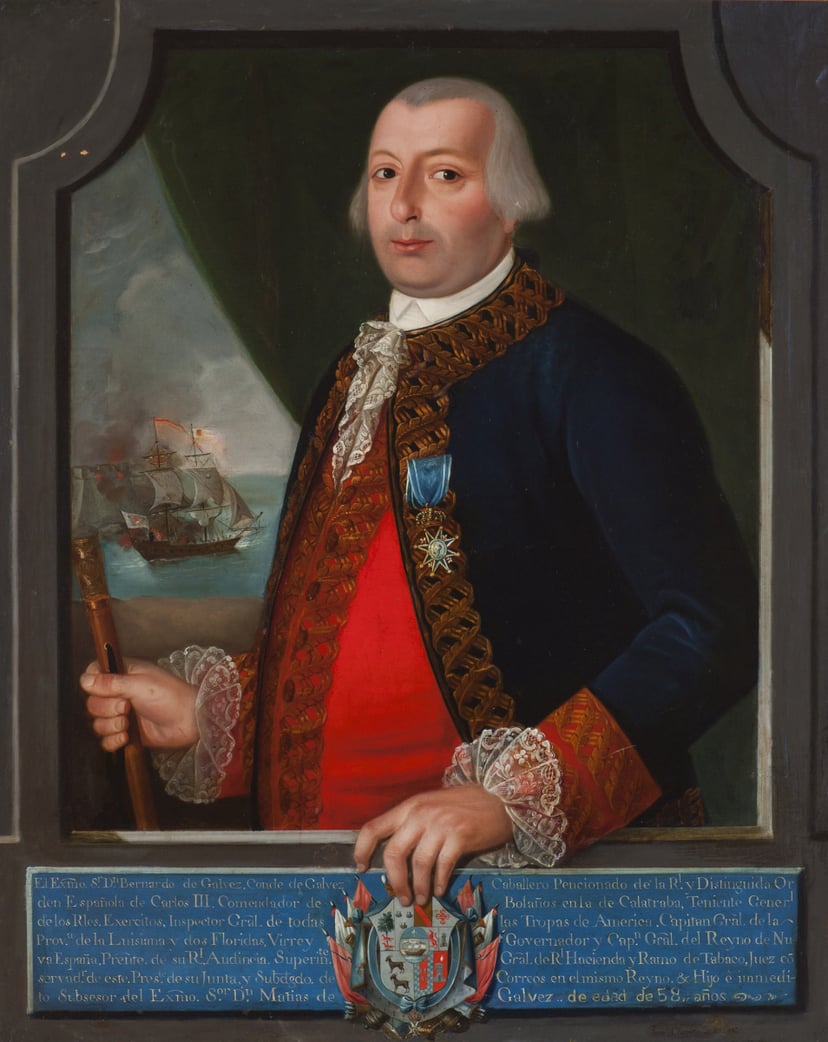
Bernardo de Gálvez

The Most Excellent Field Marshall The Viscount of Galveston | |
|---|---|
| 49th Viceroy of New Spain | |
| In office 17 June 1785 – 30 November 1786 | |
| Monarch | Charles III |
| Preceded by | Matías de Gálvez y Gallardo |
| Succeeded by | Alonso Núñez de Haro y Peralta |
| 5th Spanish Governor of Louisiana | |
| In office 1777–1783 | |
| Monarch | Charles III |
| Preceded by | Luis de Unzaga |
| Succeeded by | Esteban Rodríguez Miró |
| Personal details | |
| Born | Bernardo de Gálvez y Madrid (1746-07-23)23 July 1746 Macharaviaya, Málaga, Crown of Castile, Spain |
| Died | 30 November 1786(1786-11-30)(aged 40) Tacubaya District, Mexico City, New Spain |
| Nationality | Spanish |
| Awards | Order of Charles III |
| Signature |  |
| Military service | |
| Allegiance | Spain |
| Branch/service | Spanish Army |
| Years of service | 1762–1786 |
| Rank | Captain General Marshal |
| Battles/wars | American Revolutionary War
|
Bernardo Vicente de Gálvez y Madrid, 1st Viscount of Galveston, 1st Count of Gálvez (23 July 1746 – 30 November 1786) was a Spanish military leader and colonial administrator who served as colonial governor of Spanish Louisiana and Cuba, and later as Viceroy of New Spain.
Gálvez aided France and the newly formed nation the United States of America in the international war against Britain, defeating the British at the Siege of Pensacola (1781) and conquering West Florida. Following Gálvez's successful campaign the whole of Florida was returned to Spain in the Treaty of Paris. He spent the last two years of his life as Viceroy of New Spain, succeeding his father Matías de Gálvez y Gallardo. The city of Galveston, Texas, was named after him.
Gálvez is one of only eight people to have been awarded honorary United States citizenship.[1]
The Most Excellent Field Marshall The Viscount of Galveston | |
|---|---|
| 49th Viceroy of New Spain | |
| In office 17 June 1785 – 30 November 1786 | |
| Monarch | Charles III |
| Preceded by | Matías de Gálvez y Gallardo |
| Succeeded by | Alonso Núñez de Haro y Peralta |
| 5th Spanish Governor of Louisiana | |
| In office 1777–1783 | |
| Monarch | Charles III |
| Preceded by | Luis de Unzaga |
| Succeeded by | Esteban Rodríguez Miró |
| Personal details | |
| Born | Bernardo de Gálvez y Madrid (1746-07-23)23 July 1746 Macharaviaya, Málaga, Crown of Castile, Spain |
| Died | 30 November 1786(1786-11-30)(aged 40) Tacubaya District, Mexico City, New Spain |
| Nationality | Spanish |
| Awards | Order of Charles III |
| Signature |  |
| Military service | |
| Allegiance | Spain |
| Branch/service | Spanish Army |
| Years of service | 1762–1786 |
| Rank | Captain General Marshal |
| Battles/wars | American Revolutionary War
|
Origins and military career

Portrait by José Germán Alfaro, 1785
Bernardo de Gálvez was born in Macharaviaya, a mountain village in the province of Málaga, Spain, on 23 July 1746.[2][3][4][5] He studied military sciences at the Academia de Ávila and at the age of 16 participated in the Spanish invasion of Portugal, which stalled after the Spanish had captured Almeida. Following the conflict he was promoted to infantry lieutenant.[6] He arrived in Mexico, which was then part of New Spain, in 1769.[7][8] As a captain, he fought the Apaches, with his Opata Indian allies.[9][10] He received many wounds, several of them serious.[11] In 1770, he was promoted to commandant of arms of Nueva Vizcaya and Sonora, northern provinces of New Spain.[12]
In 1772, Gálvez returned to Spain in the company of his uncle, José de Gálvez. Later, he was sent to Pau, France, where he served with the Royal Cantabria regiment,[13] an elite Franco-Spanish unit, for three years. There, he learned to speak French, which served him well when he became governor of Louisiana. He was transferred to Seville in 1775, and then he participated in Alejandro O'Reilly's disastrous expedition to Algiers. Gálvez himself was seriously wounded in the line of duty when Spanish forces assaulted the fortress that guarded the city;[14][15] he was later appointed a professor at the military academy of Ávila and promoted to lieutenant colonel. He was made colonel in 1776.[11]
Spanish governor of Louisiana
On 1 January 1777, Bernardo de Gálvez became the new governor of the formerly French province of Louisiana,[11][16] the vast territory that later became the object of the Louisiana Purchase. It had been ceded by France to Spain in 1762, ostensibly as compensation for the loss of Florida to Britain, when Spain was urged late in the Seven Years' War to enter into battle on the French side. In 1779, he was promoted to brigadier.[17]
In November 1777, Gálvez married Marie Félicité de Saint-Maxent d'Estrehan, the Creole daughter of Gilbert Antoine de Saint-Maxent and young widow of Jean-Baptiste d'Estrehan's son. This marriage to the daughter of a Frenchman and the Creole Elizabeth La Roche[18][19] won Gálvez the favor of the local Creole population.[20][21] They had three children, Miguel, Matilde, and Guadalupe.[22]
Gálvez practiced an anti-British policy as governor, taking measures against British smuggling and promoting trade with France.[23][24] He damaged British interests in the region and kept it open for supplies to reach George Washington's Army.[25][26][27] He founded Galvez Town in 1779,[26] promoted the colonization of Nueva Iberia, and established free trade with Cuba and Yucatán.[28] Galvez Street in New Orleans is named for him.
American Revolutionary War
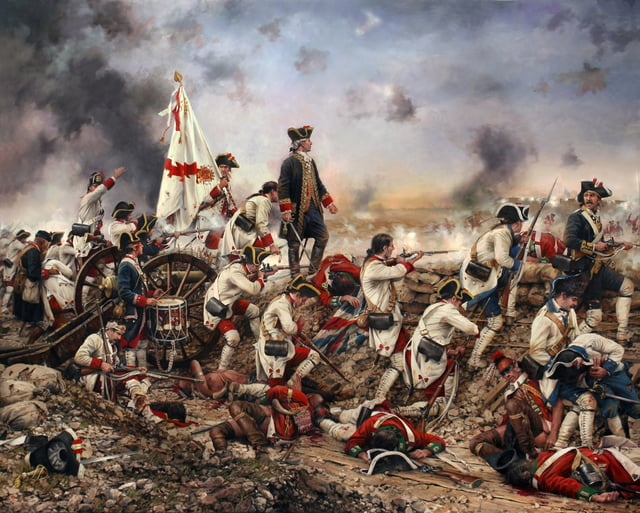
Painting of Gálvez at the Siege of Pensacola by Augusto Ferrer-Dalmau
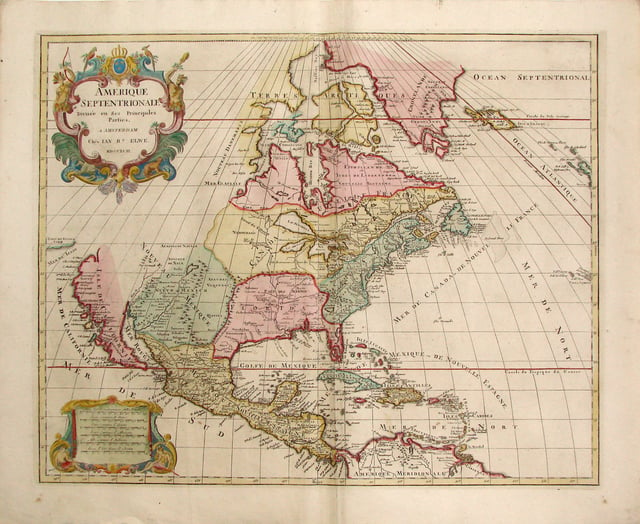
Norteamerica, 1792, Jaillot-Elwe, Spanish Florida's borders after Bernardo Gálvez's military actions, which appear to include Spanish Louisiana and Spanish Texas, as well
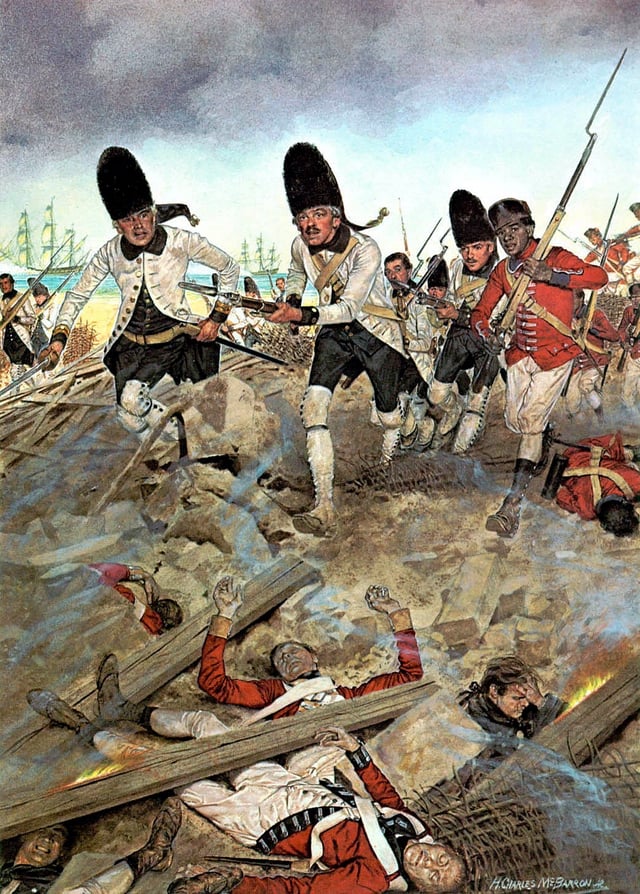
Spanish troops storm the British positions at the Siege of Pensacola (1781)
In December 1776, King Charles III of Spain decided that covert assistance to the United States would be strategically useful, but Spain did not enter into a formal alliance with the U.S.[29] In 1777, José de Gálvez, newly appointed as minister of the Council of the Indies, sent his nephew, Bernardo de Gálvez, to New Orleans as governor of Luisiana with instructions to secure the friendship of the United States.[30] On 20 February 1777, the Spanish king's ministers in Madrid secretly instructed Gálvez to sell the Americans desperately needed supplies.[24] The British had blockaded the colonial ports of the Thirteen Colonies, and consequently the route from New Orleans up the Mississippi River was an effective alternative. Gálvez worked with Oliver Pollock, an American patriot, to ship gunpowder, muskets, uniforms, medicine, and other supplies to the American rebels.[31]
Although Spain had not yet joined the American cause, when an American raiding expedition led by James Willing showed up in New Orleans with booty and several captured British ships taken as prizes, Gálvez refused to turn the Americans over to the British.[31][32][33] In 1779, Spanish forces commanded by Gálvez seized the province of West Florida, later known as the Florida Parishes, from the British.[34] Spain's motive was the chance both to recover territories lost to the British, particularly Florida, and to remove the ongoing British threat.[35][36][37]
On 21 June 1779, Spain formally declared war on Great Britain.[38][39][40] On 25 June, a letter from London, marked secret and confidential, went to General John Campbell at Pensacola from King George III and Lord George Germain.[41] Campbell was instructed that it was the object of greatest importance to organize an attack upon New Orleans.[42] If Campbell thought it was possible to reduce the Spanish fort at New Orleans, he was ordered to make preparations immediately. These included securing from Vice-Admiral Sir Peter Parker as many fighting ships as the fleet at Jamaica could spare,[43] gathering all forces in the province that could be assembled, recruiting as many loyal Indians as the Superintendent could provide,[44] and drawing on His Majesty's Treasury through the Lords Commissioners to pay expenses.[45] As an unfortunate twist of fate for Campbell, upon which his whole career was decided, the secret communication fell into the hands of Gálvez. After reading the communication from King George III and Germain, Gálvez, Governor of Louisiana, swiftly and secretly organized Louisiana and New Orleans for war.[46]
Gálvez carried out a masterful military campaign and defeated the British colonial forces at Fort Bute, Baton Rouge, and Natchez in 1779.[47][48] The Battle of Baton Rouge, on 21 September 1779, freed the lower Mississippi Valley of British forces and relieved the threat to the capital of Louisiana, New Orleans. In March, 1780, he recaptured Mobile from the British at the Battle of Fort Charlotte.[49][50]
Gálvez's most important military victory over the British forces occurred 8 May 1781, when he attacked and took by land and by sea Pensacola, the British (and formerly, Spanish) capital of West Florida from General John Campbell of Strachur.[51][52] The loss of Mobile and Pensacola left the British with no bases along the Gulf coast.[53] In 1782, forces under Gálvez's overall command captured the British naval base at Nassau on New Providence Island in the Bahamas. He was angry that the operation had proceeded against his orders to cancel, and ordered the arrest and imprisonment of Francisco de Miranda, aide-de-camp of Juan Manuel Cajigal, the commander of the expedition. Miranda later ascribed this action on the part of Gálvez to jealousy of Cajigal's success.[54][55]
Gálvez received many honors from Spain for his military victories against the British, including promotion to lieutenant general and field marshal,[56] governor and captain general of Louisiana and Florida (now separated from Cuba), the command of the Spanish expeditionary army in America, and the titles of viscount of Gálveztown and count of Gálvez.[57]
The American Revolutionary War ended while Gálvez was preparing a new campaign to take Jamaica. The importance of Gálvez's campaign from the American perspective was that he denied the British the opportunity of encircling the American rebels from the south, and kept open a vital conduit for supplies. Gálvez also assisted the American revolutionaries with supplies and soldiers, much of it through Oliver Pollock,[58] from whom he received military intelligence concerning the British in West Florida.[59][60] Gálvez found it convenient for France and Spain to advance the cause of the American revolutionaries; his military success led to the inclusion of provisions in the Peace of Paris (1783) that officially returned Florida, now divided into two provinces, East and West Florida, to Spain. The treaty recognized the political independence of the former British colonies to the north, and its signing ended their war with the British.[61][62]
Viceroy of New Spain
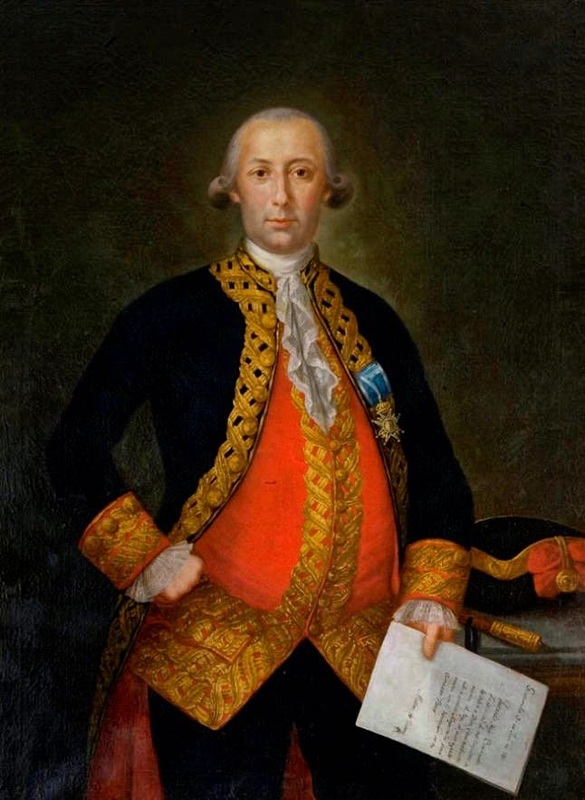
Portrait of Gálvez displayed at the United States Congress, by Mariano Salvador Maella
In 1783, Bernardo de Gálvez was ennobled to the rank of count, promoted to lieutenant-general of the army, and appointed governor and captain-general of Cuba.[63] He returned to the Indies in October of the following year to assume his new office. Shortly after he arrived in Havana, his father, Matías de Gálvez y Gallardo (then the viceroy of New Spain), died in November, and Bernardo de Gálvez was appointed to fill the position.[64] He arrived in Vera Cruz, on 21 May 1785,[65] and made his formal entry into Mexico City in June.
During his administration two great calamities occurred: the freeze of September 1785, which led to famine in 1786,[66] and a typhus epidemic that killed 300,000 people the same year.[67] During the famine, Gálvez donated 12,000 pesos of his inheritance and 100,000 pesos he raised from other sources to buy maize and beans for the populace.[68] He also implemented policies to increase future agricultural production.
In 1785, Gálvez initiated construction of Chapultepec Castle.[69][70][71] He also ordered the construction of the towers of the cathedral and paving of the streets, as well as the installation of street lights in Mexico City.[72] He continued work on the highway to Acapulco,[68][73][74] and took measures to reduce the abuse of Indian labor on the project. He dedicated 16% of the income from the lottery and other games of chance to charity.
Gálvez helped advance science in the colony by sponsoring the Royal Botanical Expedition to New Spain, led by Martín Sessé y Lacasta. This expedition of botanists and naturalists resulted in a comprehensive catalog, a collaborative work published in Spain as the Flora Mexicana, which catalogued the diverse species of plants, birds, and fish found in New Spain.[75]
After the typhus epidemic of 1786 had abated in early autumn, Bernardo de Gálvez apparently became one of its last victims,[77] and was confined to his bed. On 8 November 1786, he turned over all his governmental duties except the captain generalship to the Audiencia.[78] He died 30 November 1786, in Tacubaya (now part of Mexico City), at age 40. Gálvez was buried next to his father in the church of San Fernando in the city proper.[79][80]
Bernardo de Gálvez left some writings, including Ordenanzas para el Teatro de Comedias de México[81] and Instrución para el Buen Gobierno de las Provincias Internas de la Nueva España (Instructions for Governing the Interior Provinces of New Spain, 1786),[82] the latter of which remained in effect until the colonial period ended.[83] In his "Instructions", Gálvez advocated a policy of selling the Indians rifles and trade goods to make them dependent on the Spanish government,[84] and sanctioned war against the Apache if these inducements failed to pacify them.[85][86]
Legacy
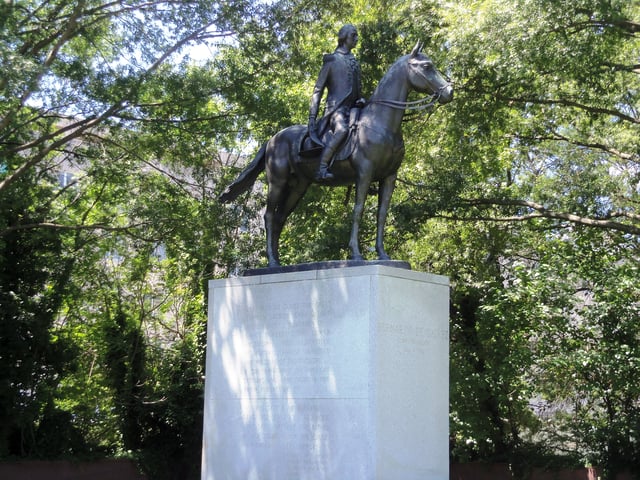
Equestrian statue of Gálvez in Virginia Avenue, Washington D.C.
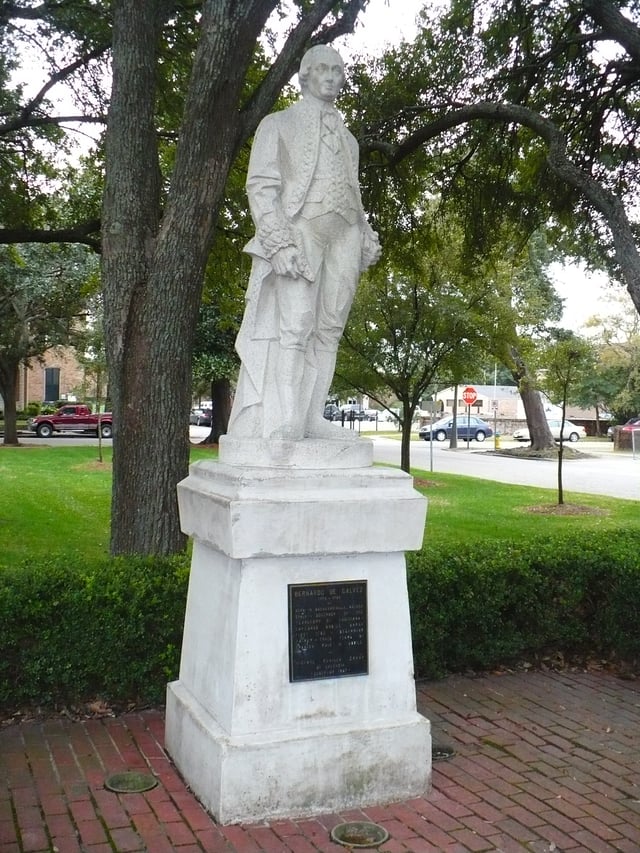
Statue of Bernardo de Galvez in Spanish Plaza, Mobile, Alabama
Galveston, Texas, Galveston Bay, Galveston County, Galvez, Louisiana, and St. Bernard Parish, Louisiana were, among other places, named after him. The Louisiana parishes of East Feliciana and West Feliciana (originally a single parish) were said to have been named for his wife Marie Felicite de Saint-Maxent d'Estrehan.[87]
The Cabildo, a branch of the Louisiana State Museum located on Jackson Square in New Orleans, has a portrait of General Gálvez accompanied by a display of biographical information. Spanish Plaza, in the Central Business District of the city, has an equestrian statue of Gálvez adjacent to the New Orleans World Trade Center.[88] There is also a Galvez Street in New Orleans.[89] Mobile, Alabama, also has a Spanish Plaza with a statue of Gálvez.[90]
In Baton Rouge, Louisiana (present-day state capital), Galvez Plaza is laid out next to City Hall and used frequently as a site for municipal events.[91] Also, the 13-story Galvez Building is part of the state government's administrative office-building complex in the Capitol Park section of downtown Baton Rouge.
In 1911 in Galveston, the Hotel Galvez was built and named after him; Avenue P, where the hotel is located, is known as Bernardo de Galvez Avenue. The hotel was added to the National Register of Historic Places on 4 April 1979.
On December 16, 2014, the United States Congress conferred honorary citizenship on Gálvez, citing him as a "hero of the Revolutionary War who risked his life for the freedom of the United States people and provided supplies, intelligence, and strong military support to the war effort."[92]
See also
Bernardo de Gálvez, the 1976 equestrian statue in Washington, D.C.
Gálveztown (brig sloop) – captured British ship renamed and participated in the capture of Mobile (1780); replica built in Spain more than 200 years later.
Spain and the American Revolutionary War
Matías de Gálvez y Gallardo, Bernardo's father
José de Gálvez, Bernardo's uncle
